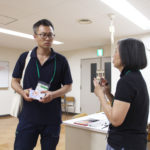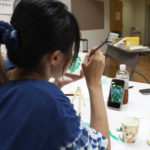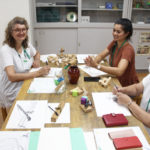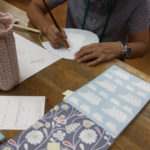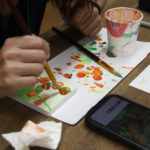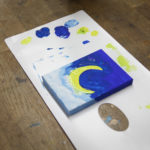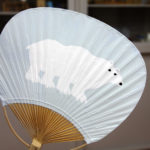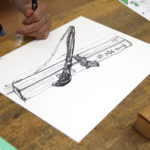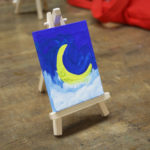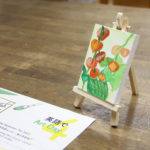English Square 4 – Art Day
““Don’t Worry About Mistakes. Making Things Out Of Mistakes, That’s Creativity”
Art Talk
ES Art Day – 9/7/2023
Due to our first class becoming contour class, which was initially planned for today, we got to have a mixed art day. We chose between painting an uchiwa, doing a mini-painting, and drawing contour. We were joined by two guests!最初の授業が輪郭画の授業になったため、当初今日の予定だったミックス・アートの日になった。私たちは、うちわを描くか、ミニペインティングをするか、輪郭を描くかを選んだ。私たちは2人のゲストと一緒に参加した。
Both painting teams used acrylic gouache. Unlike watercolor, gouache is mostly opaque, so you can paint right over your sketch.
両ペインティングチームともアクリルガッシュを使用した。水彩とは異なり、ガッシュはほとんど不透明で、スケッチの上からすぐに塗ることができる。
Let’s talk about transparency with different types of paint. We will rank them from “transparent” to “opaque.” In otherwords, we’ll rank their opacity. (オパーセティー ・ 不透明度)
それでは、さまざまな種類のペイントを使って透明性についてお話ししましょう。「透明」なものから「不透明」なものまで、ランク付けをしよう。つまり、不透明度をランク付けします。
_________________________
1.
Watercolor:
Watercolors are very transparent. This means they are very clear, like looking through a window. When you use watercolors, the paper underneath can be seen.
水彩絵の具は非常に透明です。これは、窓を通して見るようにとても明確です。水彩絵の具を使うと、下の紙が見えます。
2.
True Gouache (Traditional Gouache):
We aren’t using true gouache. Gouache is a bit like watercolor but not as clear. It’s more like frosted glass – you can’t see through it completely.
今は私たち使っていません。グアッシュは水彩画に少し似ていますが、それほどはっきりとは見えません。それはもうすこし霞んでいるガラスのようなものです – 完全には見えません。
3.
Acrylic Paint:
Acrylic paint is not as clear as watercolor. It’s more like a thin curtain – you can see some light coming through, but not much.
アクリル絵の具は水彩画よりも透明ではありません。それはもうすこし薄いカーテンのようなものです – 光が少しは通りますが、あまり多くはありません。
4.
Acrylic Gouache:
This is what we’re using. Acrylic gouache is very solid and not clear at all. It’s like a thick curtain – no light can pass through.
今、私たちが使っています。 アクリルグアッシュは非常にしっかりしており、全く透明ではありません。それは厚いカーテンのようなものです – 光は通りません。
5.
Oil Paint:
Oil paint is not clear at all. It’s like a wall – no light can get through it.
油絵の具は全く透明ではありません。それは壁のようなものです – 光は通りません。
_________________________
So, what order do we paint in? This question came up from an artist in class.
Watercolor – Transparent/Translucent – Paint from light to dark. (add thin colors in layer by layer, working your way to shadows)
Traditional Gouache – Translucent – Paint from light to dark.
Acrylic – Translucent/Opaque – Flexible
Acrylic Gouache – More Opaque – Flexible
Oil Paint – Opaque – Paint dark first, thinly, and work to light. Light colors are less opaque, so they are painted more thickly.
Traditionally, transparent paint is painted from light to dark, and opaque paint is painted from dark to light. However, even though we’re using mostly opaque paint, it’s not totally opaque. Therefore, the artist has flexibility to paint in any order they like. For me, I like to paint a neutral color, then block in my shadows in highlights. From there, I paint everything in-between. After blocking, I can get more and more detailed, where I want the focus to be.
伝統的に、透明塗料は明るいところから暗いところへ、不透明塗料は暗いところから明るいところへ塗られる。しかし、ほとんど不透明な絵具を使っているとはいえ、完全に不透明というわけではない。そのため、画家は好きな順番で自由に描くことができる。私の場合、中間色を塗ってから、ハイライトで影をブロックするのが好きだ。そこからどんどん細かくしていく。
For you, I’d like you to check “your white” and “your black” in each scene. What is the brightest part? What is the darkest part? Those colors become “your white” and “your dark.” That is how you understand the range of your colors.
皆さんは、それぞれのシーンで「your white」と「your black」をチェックしてほしいね!一番明るい部分は?一番暗いところは?それが「自分の白」と「自分の黒」になる。そうやって自分の色の幅を理解するんだ。
Let’s think about some art together. With the following artists, ask yourself:
1. Is it simple? Is it complex? Why?
2. Where does my eye go? What path does my eye follow? Why?
3. Do I like it? Do I dislike it? Why?
Here I’ll share some painters with you:
Joaquín Sorolla – Under the Awning, on the Beach of Zarautz (1910)
Zhang Keyang, Wulanmuqi Art Troop of Inner Mongolia Autonomous Region
Clarice Beckett, Evening, St Kilda Road (1930)
Andrew Wyeth, Wind From The Sea (1947)
As you can see, “simple” and “complex” can both be very, very good. A simple painting isn’t a bad painting. Let me know which of these you like best!
English
light to dark – 光から闇へ
dark to light – 闇から光へ
in-between – 中間 (Do you remember this phrase from somewhere else?)
thickly – 厚く
thinly – 薄く
transparent – 透明
translucent – 半透明
opaque – 不透明
respectively – 順番に Ie: “My favorite ice creams are hazelnut and goma, respectively.” (#1, #2 のニュアンスが分かります)
block – to place paint in broad, general chunks before you paint in detail.
blocking – Commonly used with “in,” as in “blocking in color.” Ie: I’m finished blocking in my shadows.
Pronunciation
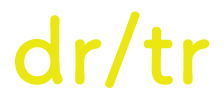
Class 1’s Hatsuon Point: DR/TR
“DR” and “CHR” make sounds like JR and TR respectively in conversation. The individual letters aren’t pronounced– this is a combined sound called a “consonant cluster.” That’s pretty difficult– you don’t have to remember it. Just remember that these combinations are always pronounced (in American English) as a set, and they only make the sounds I mentioned before! Even if the sounds are in the middle of the word, this rule stands. For example: Extra, Hundred.
Actually, I have two worksheets I thought I’d share with you. They’re actually from when I taught Elementary school, but maybe you’ll have fun with them. You can use them to practice your pronunciation!
“DR Pronunciation Worksheet”
![一般社団法人 北上国際交流協会[北上市国際交流ルーム]](http://k-iah.com/kiah/wp-content/themes/kiah0606/images/site-logo2_footer.png)
![一般社団法人 北上国際交流協会[北上市国際交流ルーム]](http://k-iah.com/kiah/wp-content/themes/kiah0606/images/site-logo2.png)
